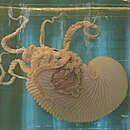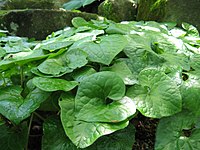en
names in breadcrumbs


The species is heavily preyed upon by tunas, billfishes, and dolphin.
This animal is very common but is rarely spotted by humans. Every once and a while many of them may be washed up by a change in currents or chased into shallow waters by predators, allowing people to observe and catch them.
Can be found in fish markets in India and Japan. The shell is praised by collectors because of its beauty, coloration, sculpture, and fragility.
Feeds on plankton and small organisms on the surface of the water.
Warm temperate and tropical seas around the world.
Biogeographic Regions: indian ocean (Native ); atlantic ocean (Native ); pacific ocean (Native )
Likes to be near the surface of the water. It is an epipelagic oceanic species.
Aquatic Biomes: reef ; coastal
The maximum length of shell is 30 cm in females, but only 1.5-2 cm in males. The shell is coiled and laterally compressed with a narrow keel and numerous sharp nodules. Nodules toward the center of the coil are brown, but most of the shell is white.
Other Physical Features: ectothermic ; bilateral symmetry
The male uses a specialized arm called a 'hectocotylus' to fertilize the eggs. The hectocotylus is inserted into the females pouch and breaks off during mating. The female forms a "nacelle," a thin calcareous shell, with two of her legs (the others are used for swimming). This structure holds the eggs throughout development.
Argonauta argo, also known as the greater argonaut, is a species of pelagic octopus belonging to the genus Argonauta. The Chinese name for this species translates as "white sea-horse's nest".[2]
A. argo was the first argonaut species to be described and is consequently the type species of the genus. The type specimen of A. argo was collected in the Mediterranean Sea and is deposited at the Linnean Society of London.[3]
A. argo is the largest species in the genus and also produces the largest eggcase. Live animals have a characteristic blue sheen on the first arm pair and around the eyes.[2] The eggcase is characterised by two rows of small, sharp tubercles running along a narrow keel, smooth ribs across the walls of the shell, and a thickening along the shell aperture, which forms distinct protrusions or 'horns' on either side.[2] Argonauta cygnus Monterosato, 1889 was described based on a shell which lacked these protrusions, although it is now considered a junior synonym of A. argo. The greatest recorded size of an A. argo eggcase is 300 mm.[4][5]
A damaged beak of a female A. argo (ML = 40.0 mm; caught at ), measuring 4.3 mm in hood length and 7.8 mm in crest length, is mentioned in A Handbook for the Identification of Cephalopod Beaks.[6]
A. argo is cosmopolitan, occurring in tropical and subtropical waters worldwide.[2] A dwarf form exists in the Mediterranean Sea, which was described as Argonauta argo mediterranea Monterosato, 1914, although this taxon is now regarded as invalid.
The female of the species, like all argonauts, creates a paper-thin eggcase that coils around the octopus much like the way a nautilus lives in its shell, hence the name paper nautilus.
A. argo is thought to feed primarily on pelagic molluscs. The species is preyed on by numerous predators. It has been reported in the stomach contents of Alepisaurus ferox from the south-western Pacific.[7]
Males of this species reach sexual maturity at a mantle length (ML) of 8 mm.[8] Females mature at about double the size of Argonauta bottgeri and Argonauta hians.[8] They begin to secrete an eggcase at 6.5–7.0 mm ML.[8] Eggs are usually laid when females reach 14–15 mm ML, although the size at which this takes place differs across the animal's range.[9] A small A. argo residing in an 88 mm long eggcase was estimated to be carrying 48,800 embryos.[10] Females grow to 100 mm ML, while males do not exceed 20 mm ML.[2]
In the open ocean, A. argo has been observed attached to jellyfish.[11] This behaviour has been known for a long time,[11][12] although little was understood about the relationship prior to the work of Heeger et al. in 1992.[13][14] In "Predation on jellyfish by the cephalopod Argonauta argo", Heeger et al. describe their observations of a female A. argo found atop a host jellyfish. The argonaut was seen holding on to the aboral (exumbrellar) surface of the jellyfish using its lateral and ventral arms. The authors found that about half of the animal's aboral surface was damaged and large pieces of mesoglea were missing, presumably removed by the argonaut. Additionally, two holes, apparently bite marks, were found in the center of this area with channels leading from these holes into the gastral cavity of the jellyfish. The argonaut presumably used these channels to suck food particles from the gastral cavity. Heeger et al. suggested that "the association provided shelter or camouflage for the argonaut".[13][14]
Observations of captive A. argo females suggest that the expanded webs of the dorsal arms may aid the animal in feeding. Mark Norman mentions, "when food was touched against the spread webs, an arm shot out of the shell in a sweeping action, grabbing the prey".[2] Argonauts are not thought to actively hunt, but employ this method to catch animals that bump into them in the open ocean.[2]
A. argo is occasionally involved in mass strandings along the South African and southern Australian coastlines. The strandings are seasonal and generally occur between April and August, towards the end of the animals' spawning season.

In Japanese, this species is called "Aoi-gai" (kanji: 葵貝, Katakana: アオイガイ[15]), which means "Shell of Aoi" (not Malva but Asarum caulescens).[16] Japanese have compared two eggcases of argonauts lapped each other to a leaf of Asarum caulescens.[16] Another name is "Kaidako" (kanji: 貝蛸 or 貝鮹, Katakana: カイダコ[15]), which means "Shell Octopus".
One of the earliest known depictions of A. argo, from Index Testarum Conchyliorum (1742) by Niccolò Gualtieri
Argonauta argo, also known as the greater argonaut, is a species of pelagic octopus belonging to the genus Argonauta. The Chinese name for this species translates as "white sea-horse's nest".
A. argo was the first argonaut species to be described and is consequently the type species of the genus. The type specimen of A. argo was collected in the Mediterranean Sea and is deposited at the Linnean Society of London.